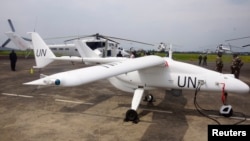UNITED NATIONS —
The U.N. peacekeeping chief says he plans to deploy unarmed aerial vehicles to strengthen the U.N. mission in Mali’s ability to protect civilians.
In a briefing Wednesday before the U.N. Security Council, Hervé Ladsous said the U.N. Mission in Mali, known as MINUSMA, must be in a position to identify, deter, and mitigate threats.
“In that regard, I take this opportunity to signal to the Council our intention to deploy unmanned aerial systems in order to enhance the situational awareness of MINUSMA as well as its ability to protect civilians and its own personnel,” said Ladsous.
He did not go into details on the numbers of drones the United Nations would like for the mission or when they could actually be deployed. Such a process could take several months.
The United Nations has been using unmanned, unarmed drones in the eastern Democratic Republic of Congo for several months as a test case.
They say the fleet of five UAVs has proved very helpful in the protection of civilians and the delivery of humanitarian aid, as they can provide peacekeepers with real-time information on the movements of rebel groups over a large area of difficult terrain they otherwise would not be able to cover.
Malian Foreign Minister Abdoulaye Diop said his government approved of the use of the unarmed drones.
“These engines have not yet been deployed, but we hope it could be done as soon as possible,” said Diop.
Ladsous said a successful political process is vital to stabilizing Mali and urged the government and armed groups in the north to accelerate their efforts to achieve this.
“The status quo cannot stand. Progress in the political process is urgent and the time for peace talks is now,” said Ladsous.
He said the lack of dialogue has led to the sharp decline in the security situation in Kidal, where armed groups have seized military and, to an extent, administrative control over the area.
The Security Council is due to review and renew the U.N. mission’s mandate at the end of this month.
In a briefing Wednesday before the U.N. Security Council, Hervé Ladsous said the U.N. Mission in Mali, known as MINUSMA, must be in a position to identify, deter, and mitigate threats.
“In that regard, I take this opportunity to signal to the Council our intention to deploy unmanned aerial systems in order to enhance the situational awareness of MINUSMA as well as its ability to protect civilians and its own personnel,” said Ladsous.
He did not go into details on the numbers of drones the United Nations would like for the mission or when they could actually be deployed. Such a process could take several months.
The United Nations has been using unmanned, unarmed drones in the eastern Democratic Republic of Congo for several months as a test case.
They say the fleet of five UAVs has proved very helpful in the protection of civilians and the delivery of humanitarian aid, as they can provide peacekeepers with real-time information on the movements of rebel groups over a large area of difficult terrain they otherwise would not be able to cover.
Malian Foreign Minister Abdoulaye Diop said his government approved of the use of the unarmed drones.
“These engines have not yet been deployed, but we hope it could be done as soon as possible,” said Diop.
Ladsous said a successful political process is vital to stabilizing Mali and urged the government and armed groups in the north to accelerate their efforts to achieve this.
“The status quo cannot stand. Progress in the political process is urgent and the time for peace talks is now,” said Ladsous.
He said the lack of dialogue has led to the sharp decline in the security situation in Kidal, where armed groups have seized military and, to an extent, administrative control over the area.
The Security Council is due to review and renew the U.N. mission’s mandate at the end of this month.





